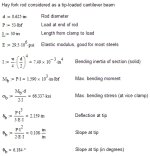CraigM
Silver Member
I'm designing a hay fork for my B2150. It will lift 4 bales at a time. The bales are stacked 2 wide x 2 high to make a 200 pound cube about 36 on a side. I envision 4-8 round spikes, like a tine bucket
A quick test of a possible spike using a 50# bag of feed in a 5 gallon bucket says that 5/8" diameter rod clamped in a pipe vice will hold 53# at a distance of 30" from the support, and spring back when the weight is removed.
With that as a starting point, I got out the books to 'experiment' with different rod diameters and lengths. When I calculated the stress in the 5/8" test, I got 66ksi. Interesting for mild steel that should only be able to withstand 30-36ksi. I went back to the shop and tried again with other rods and was able to get calculated stresses as high as 100ksi without bending the rods.
The equations I'm using are:
Stress in a cantilever beam = (My)/I. M is bending moment, y is distance from neutral axis...the radius of the rod in this case, and I is (Pi/4)r^4 where r is the radius of the rod. Pi is that magic 3.14 but I'll have to write it as Pi since I don't know how to make the symbol.
When I do the calculations with 5/8" dia, 53#, and 30" I get M = 1590 in#, I = .0075 in^4, y=.3125 in. This gives a stress of 66ksi.
It's been way too long since school and engineering lab. Can someone tell me what I'm missing?
A quick test of a possible spike using a 50# bag of feed in a 5 gallon bucket says that 5/8" diameter rod clamped in a pipe vice will hold 53# at a distance of 30" from the support, and spring back when the weight is removed.
With that as a starting point, I got out the books to 'experiment' with different rod diameters and lengths. When I calculated the stress in the 5/8" test, I got 66ksi. Interesting for mild steel that should only be able to withstand 30-36ksi. I went back to the shop and tried again with other rods and was able to get calculated stresses as high as 100ksi without bending the rods.
The equations I'm using are:
Stress in a cantilever beam = (My)/I. M is bending moment, y is distance from neutral axis...the radius of the rod in this case, and I is (Pi/4)r^4 where r is the radius of the rod. Pi is that magic 3.14 but I'll have to write it as Pi since I don't know how to make the symbol.
When I do the calculations with 5/8" dia, 53#, and 30" I get M = 1590 in#, I = .0075 in^4, y=.3125 in. This gives a stress of 66ksi.
It's been way too long since school and engineering lab. Can someone tell me what I'm missing?

